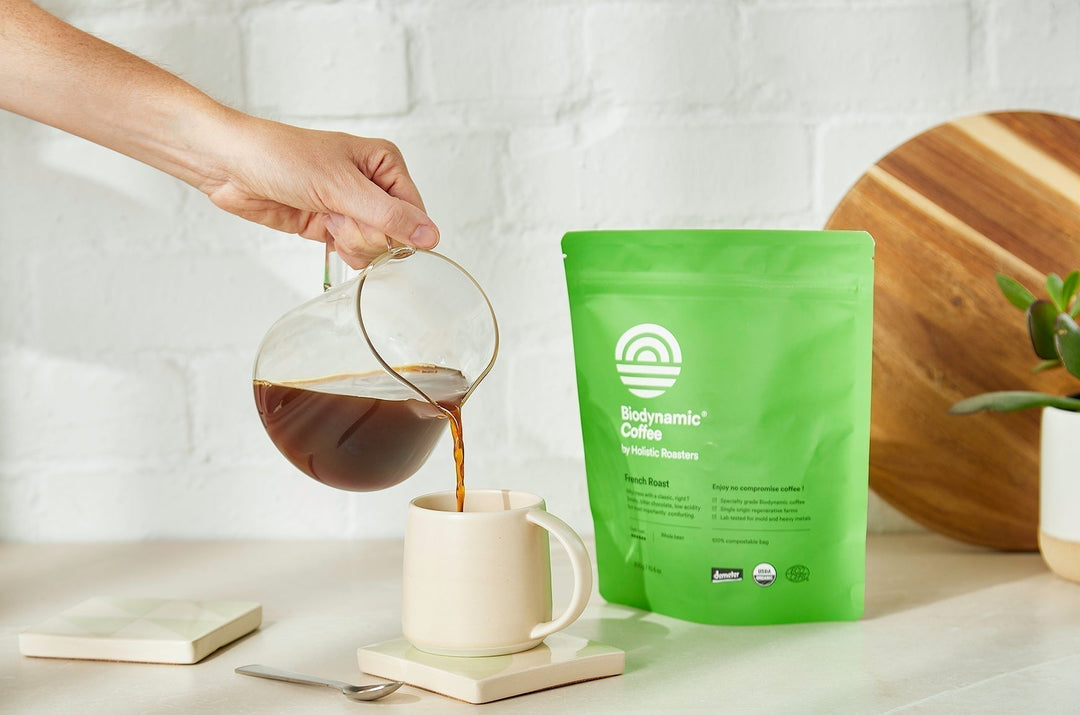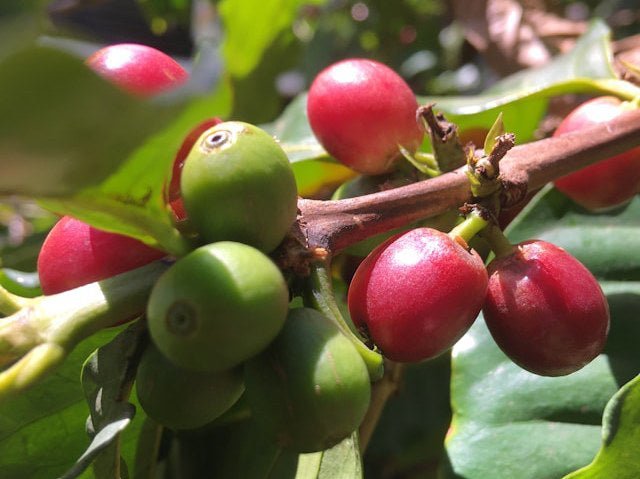Shade-Grown Coffee: The Secret to Better Flavor & a Healthier Planet
Forest Canopies Make Better, Healthier Coffee
Have you ever sipped a cup of coffee that seemed unusually sweet, balanced, and complex—like it had its own ecosystem in the flavor? Chances are, that coffee came from a farm where tall trees shaded the coffee plants below. Shade-grown coffee isn't just a romantic idea; it's a proven way to enhance flavor while restoring balance to our ecosystems.

The Quick Scoop
Shade-grown coffee develops slowly under forest canopies, resulting in beans with brighter fruit notes, deeper sweetness, and longer finishes. Beyond flavor, these farms support up to 150 bird species, sequester 40+ tons of CO₂ per hectare, and supports the elimination of pesticides. It's coffee that tastes better because it's grown better.
How Shade Shapes Flavor
Coffee cherries ripen slowly under forest canopies. The trees moderate heat, conserve soil moisture, and protect plants from harsh winds. This gentler microclimate allows sugars and acids to develop in harmony—often producing beans with distinct characteristics that vary by shade level.
Temperature Moderation
Shade reduces temperature by 4-6°C, protecting coffee from heat stress and allowing slower cherry maturation for enhanced sugar development.
Moisture Retention
Canopy cover reduces evaporation by 30%, maintaining consistent soil moisture that supports steady nutrient uptake and flavor compound synthesis.
UV Protection
Filtered sunlight reduces UV stress on coffee plants, preserving delicate aromatic compounds that contribute to floral and fruit notes.
In fact, researchers have found that shade helps offset the stress of hotter growing conditions. By cooling the farm environment, shade trees protect the quality of the coffee.
Flavor Takeaway
More shade often means more complexity, especially in warm lowlands where coffee plants need extra protection. Studies show that coffee grown under 40-60% shade coverage consistently scores higher in cupping evaluations for sweetness, balance, and overall quality.
An Ecosystem in Every Cup
A shaded coffee farm is alive with more than coffee trees—it hums with life. Birds, bats, bees, and butterflies find food and shelter in the canopy. In return, they provide natural pest control and pollination.
Natural Pest Control
Birds and bats reduce herbivorous insects by 64-80%, eliminating the need for pesticides while maintaining ecological balance.
Enhanced Pollination
Native bees and other pollinators thrive in shade systems, improving coffee yields and supporting surrounding ecosystem health.
Soil Enrichment
Fallen leaves create natural mulch, adding 2-4 tons of organic matter per hectare annually and recycling essential nutrients.
Biodiversity Haven
Shade farms support 120+ bird species, including migratory species, plus countless butterflies, mammals, and beneficial insects.
The result? A farm that doesn't just produce coffee but sustains an entire web of biodiversity. Studies consistently show that shade-grown coffee supports far more species of birds, mammals, and insects than sun-grown systems.
Climate Resilience and Carbon Storage
Those same trees store carbon in their trunks and branches, they naturally lock away emissions that would otherwise enter the atmosphere.
Initial Carbon Capture
Young shade trees begin sequestering 5-10 tons CO₂/hectare annually while establishing root systems and canopy structure.
Rapid Growth Phase
Mature trees accelerate carbon storage to 15-25 tons CO₂/hectare yearly, while providing optimal shade for coffee quality.
Long-term Storage
Established systems store 40-60 tons CO₂/hectare total, with some farms outperforming natural forest carbon sequestration rates.
Ecosystem Benefits
Shade canopies also keep soils cooler and moister, helping coffee survive dry spells and erratic rainfall. Research shows that shaded farms maintain soil temperatures 4-6°C cooler than sun-grown systems.
Key finding: Protecting existing shade trees is often even more impactful than planting new ones—mature trees store 3-5 times more carbon than young plantings.
Comparing Shade-Grown and Sun-Grown Coffee Systems
Understanding the differences between growing methods reveals why shade-grown coffee offers superior environmental and flavor benefits:
Environmental Comparison
| Factor | Shade-Grown | Sun-Grown |
|---|---|---|
| Bird Species Supported | 120-150 species | 5-20 species |
| Carbon Sequestration | 40-60 tons CO₂/hectare | Minimal to none |
| Pesticide Use | Minimal or none | High dependency |
| Soil Erosion | Reduced by 70% | Significant erosion risk |
| Water Retention | 30% higher | Rapid runoff |
| Temperature Regulation | 4-6°C cooler | Full sun exposure |
Coffee Quality Differences
| Attribute | Shade-Grown | Sun-Grown |
|---|---|---|
| Ripening Speed | Slow, even maturation | Rapid, uneven ripening |
| Sugar Development | High, complex sugars | Lower sugar content |
| Acidity | Balanced, bright | Often harsh or flat |
| Flavor Complexity | Multi-layered, nuanced | Simple, one-dimensional |
| Cup Score (avg) | 82-88 points | 78-82 points |
| Defect Rate | Lower defect rate | Higher defect rate |
Economic Considerations
Shade-Grown Systems offer "Hidden Yields":
- Firewood from pruning shade trees provides cooking fuel
- Fruit trees generate additional income (avocados, citrus, bananas)
- Medicinal plants can be cultivated in the understory
- Ecotourism opportunities for bird watching and farm tours
- Premium prices for certified shade-grown coffee (15-30% higher)
- Lower input costs by helping to eliminate the need for pesticides and chemical fertilizers
Long-term resilience: While sun-grown systems may produce higher yields initially, shade-grown farms show greater resilience adverse weather conditions, maintaining productivity longer and requiring less replanting.
Certifications That Matter
For coffee lovers who want to know their brew protects wildlife as much as it delights their palate, certifications provide assurance of genuine shade-grown practices:
Smithsonian Bird Friendly®
The gold standard for shade-grown coffee. Requires organic certification PLUS scientifically measured canopy structure: minimum 40% shade coverage, 12+ tree species, and 40-foot canopy height. Only 1% of global coffee meets these rigorous standards.
Demeter Biodynamic
Goes beyond organic with holistic ecosystem management. Requires 10% of farm dedicated to biodiversity, prohibits all synthetic inputs, and mandates shade trees as part of the farm organism. At Holistic Roasters, our farms already exceed these standards.
Rainforest Alliance
Focuses on sustainable farming with shade requirements varying by region. Mandates 40% canopy coverage in most areas, native tree species, and multiple canopy layers. Also includes social and economic sustainability criteria.
USDA Organic
While not specifically for shade, organic certification often correlates with shade-grown practices. Prohibits synthetic pesticides that would harm the biodiverse ecosystem shade trees support.
Why Certification Matters
Without certification, "shade-grown" claims can be misleading. Some farms maintain just a few scattered trees while essentially practicing sun cultivation. True shade-grown coffee requires measurable canopy coverage, biodiversity metrics, and ongoing monitoring. When you see these certifications, you know your coffee truly supports forest ecosystems.
Our Commitment to Forest-Grown Coffee
We work with farms that see trees not as competition but as partners. By supporting shade-grown coffee, we help create:
Better Coffee
Balanced sweetness, nuanced acidity, and longer finishes. Our shade-grown coffees consistently score 84+ points, with complex flavor profiles impossible to achieve in full sun.
Healthier Farms
Fertile soils enriched by leaf litter, natural pest control from birds and beneficial insects, and resilient plants adapted to changing weather conditions.
Thriving Ecosystems
Habitat for 150+ bird species including endangered migrants, corridors for wildlife movement, and preservation of native plant species.
Building Resilience
Each hectare of our shade-grown coffee farms stores the equivalent CO₂ of taking 20 cars off the road annually, while building resilience against extreme weather.
Frequently Asked Questions About Shade-Grown Coffee
Shade-grown coffee is cultivated under a canopy of diverse trees, mimicking coffee's natural growing conditions in Ethiopian highland forests. This method requires:
- Minimum 40% canopy coverage (ideally 40-60% for optimal quality)
- Multiple tree species creating various canopy layers
- Trees at least 40 feet tall to provide proper shade and habitat
- Native and productive tree species that benefit the ecosystem
True shade-grown coffee creates a functioning agroforestry system where coffee is just one component of a biodiverse, productive landscape that provides habitat, stores carbon, and produces superior coffee.
Shade profoundly influences coffee flavor through several mechanisms:
- Slower maturation: Cherries ripen 2-4 weeks longer, allowing more time for sugar and acid development
- Temperature moderation: Cooler conditions preserve delicate aromatic compounds
- Stress reduction: Protected plants produce fewer bitter defensive compounds
- Enhanced soil biology: Richer soil microbiomes contribute to mineral complexity
The result is coffee with brighter acidity, deeper sweetness, more complex fruit and floral notes, and a longer, cleaner finish. Cupping scores for shade-grown coffee average 3-5 points higher than sun-grown equivalents.
Shade-grown coffee delivers extensive environmental benefits:
- Biodiversity: Supports 150+ bird species, including migratory songbirds
- Carbon storage: Sequesters 40-60 tons CO₂ per hectare in tree biomass
- Soil protection: Reduces erosion by 70% compared to sun cultivation
- Water conservation: Retains 30% more soil moisture, filters runoff
- Pesticide reduction: Natural pest control eliminates need for most chemicals
- Climate resilience: Buffers temperature extremes and weather events
Research shows shade coffee farms can match 60% of native forest biodiversity while producing a valuable crop, making them crucial for conservation in agricultural landscapes.
While often related, shade-grown and organic are distinct designations:
- Organic certification focuses on prohibiting synthetic inputs but doesn't require shade trees
- Shade-grown certification requires specific canopy coverage but doesn't always prohibit chemicals
- Best practice combines both: organic methods under diverse shade canopy
The Smithsonian Bird Friendly certification requires both organic practices AND measurable shade standards, representing the gold standard. At Holistic Roasters, all our shade-grown coffees are also certified organic or Biodynamic, ensuring both environmental and health benefits.
Shade-grown coffee typically costs 15-30% more than conventional coffee, but this premium reflects true value:
- Higher production costs: Lower yields per plant, more labor for diverse system management
- Superior quality: Better flavor justifies specialty coffee pricing
- Environmental services: You're supporting carbon storage, biodiversity, and watershed protection
- Fair farmer compensation: Premium prices help farmers maintain sustainable practices
Consider it an investment: for the price of one less coffee shop visit monthly, you can ensure all your home coffee supports forest ecosystems and farming communities while delivering exceptional flavor.
Look for these indicators of genuine shade-grown coffee:
- Third-party certification: Smithsonian Bird Friendly, Rainforest Alliance, or Demeter Biodynamic
- Specific shade metrics: Reputable sellers provide canopy coverage percentages and tree species counts
- Farm transparency: Photos, videos, or virtual tours showing actual shade conditions
- Detailed origin info: Specific farm or cooperative names, not just country of origin
- Price point: True shade-grown coffee commands premium prices; suspiciously cheap "shade" coffee likely isn't
At Holistic Roasters, we provide complete transparency: farm coordinates, canopy coverage data, tree species lists, and annual biodiversity assessments for all our shade-grown offerings.
Experience the Shade-Grown Difference
Taste coffee that tells the story of an entire forest ecosystem. Every cup supports biodiversity, and delivers the complex flavors only possible when coffee grows in harmony with nature.
Use code FORESTCOFFEE for 10% off your first order of certified shade-grown coffee.
Shop Shade-Grown CoffeeReferences
- Perfecto, I., Rice, R. A., Greenberg, R., & Van der Voort, M. E. (1996). "Shade coffee: a disappearing refuge for biodiversity." BioScience, 46(8), 598-608.
- Jha, S., Bacon, C. M., Philpott, S. M., Ernesto Méndez, V., Läderach, P., & Rice, R. A. (2014). "Shade coffee: Update on a disappearing refuge for biodiversity." BioScience, 64(5), 416-428.
- Smithsonian Migratory Bird Center. (2023). "Bird Friendly Coffee Certification Standards." Washington, DC: Smithsonian Institution.
- De Beenhouwer, M., Aerts, R., & Honnay, O. (2013). "A global meta-analysis of the biodiversity and ecosystem service benefits of coffee and cacao agroforestry." Agriculture, Ecosystems & Environment, 175, 1-7.
- Tscharntke, T., Clough, Y., Bhagwat, S. A., Buchori, D., Faust, H., Hertel, D., ... & Wanger, T. C. (2011). "Multifunctional shade‐tree management in tropical agroforestry landscapes–a review." Journal of Applied Ecology, 48(3), 619-629.
- Ehrenbergerová, L., Kučera, A., Cienciala, E., Trochta, J., & Volařík, D. (2016). "Carbon stock in agroforestry coffee plantations with different shade trees in Villa Rica, Peru." Agroforestry Systems, 90(3), 433-445.
- Karp, D. S., Mendenhall, C. D., Sandí, R. F., Chaumont, N., Ehrlich, P. R., Hadly, E. A., & Daily, G. C. (2013). "Forest bolsters bird abundance, pest control and coffee yield." Ecology Letters, 16(11), 1339-1347.





